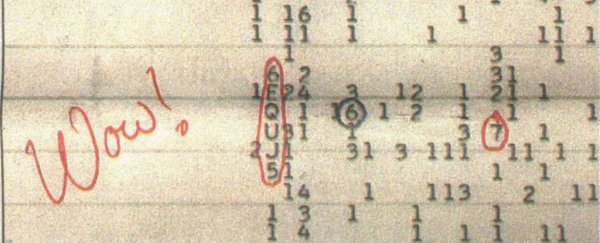The "Wow!" signal has been etched in red marker in the memory of advocates for the search for extraterrestrial intelligence (SETI) since its unveiling in 1977. To this day, it remains one of the most enigmatic radio frequency signals ever found.
Now a new paper from a wide collection of authors, including some volunteers, provides some corrections, and some new insights, into both the signal and its potential causes.
Data from 1977 was hard to parse, given the lack of modern computer systems, but volunteers from the Big Ear Observatory in Delaware, Ohio, where the original signal was collected, preserved the records after the observatory was shut down in 1998 and turned into a golf course.
Related: Famous 'Wow!' Signal Might Have Actually Been a Natural Space Laser
Using modern computing technology, the volunteers ran over 75,000 pages of original data through an optical character recognition routine, with visual help from human validators, allowing in-depth computational analysis of the original signal for the first time.
This more detailed analysis led to slight changes in three of the signal's main characteristics. It narrowed the part of the sky the signal could have emanated from, with a corresponding increase in the statistical certainty of its location by two thirds.
Its frequency was also tweaked slightly, but importantly, from 1420.4556 MHz to 1420.726 MHz. While that might not seem like much, the source would have to be spinning a lot faster to create that much of a frequency difference.

Potentially the most interesting update to the signal was a new estimate of its flux density (i.e. its strength). In the language of radio astronomy, the new value is 250 Janskys (which are 10-26 watts per m2 per Hz), whereas previous estimates put it somewhere between 54 and 212 Janskys, so the signal was actually notably higher than original estimated.
Other minor errors, such as a 21 second clock offset didn't have as much of an impact on the signal, but does on astronomers' understanding of it. And probably the largest change was a correcting for a mislabeled channel in the filter bank that caused a recalculation of the frequency.
Ultimately, the signal remains as enigmatic as ever, though the paper does try to shed some light on potential sources. They definitively rule out any man-made sources, pointing out that there were no known TV stations operating in Ohio at that point in time, nor were there any satellites overhead that could have caused the signal. The Moon was also on the other side of the planet at the time, so nothing bounced off of it.

The Sun wasn't particularly active in 1977, lowering the chances for it being caused by some sort of solar phenomenon. According to the researcher's analysis, an internal software error also isn't likely due to the high 'Gaussian' (i.e. natural) looking pattern.
That means the signal was likely astronomical in origin, though the most likely explanation still isn't extraterrestrials. The most likely culprit is a HI cloud - clouds of neutral atomic hydrogen floating in space that have been known to produce narrow-band signals that look similar to the "Wow!" Signal, but never on anything approaching the power levels seen that one time in 1977.
While the SETI community continues to puzzle over what might have caused their most famous signal, it's good to know that, even after almost five decades, scientists can still find, refine, and draw new conclusions from data. And who knows, with this update and our increased understanding, this might not be the last surprise the signal has in store for us.
This article was originally published by Universe Today. Read the original article.
